Phosphorylation and activation of PINOID by the phospholipid signaling kinase 3-phosphoinositide-dependent protein kinase 1 (PDK1) in Arabidopsis
- PMID: 16601102
- PMCID: PMC1458890
- DOI: 10.1073/pnas.0510283103
Phosphorylation and activation of PINOID by the phospholipid signaling kinase 3-phosphoinositide-dependent protein kinase 1 (PDK1) in Arabidopsis
Abstract
Activity of the serine-threonine protein kinase PINOID (PID) has been implicated in the asymmetrical localization of the membrane-associated PINFORMED (PIN) family of auxin transport facilitators. However, the means by which PID regulates PIN protein distribution is unknown. We have used recombinant PID protein to dissect the regulation of PID activity in vitro. We demonstrate that intramolecular PID autophosphorylation is required for the ability of PID to phosphorylate an exogenous substrate. PID-like mammalian AGC kinases act in a phosphorylation cascade initiated by the phospholipid-associated kinase, 3-phosphoinositide-dependent protein kinase 1 (PDK1), which binds to the C-terminal hydrophobic PDK1-interacting fragment (PIF) domain found in PDK1 substrates. We find that Arabidopsis PDK1 interacts with PID, and that transphosphorylation by PDK1 increases PID autophosphorylation. We show that a PID activation loop serine is required for PDK1-dependent PID phosphorylation. This activation is rapid and requires the PIF domain. Cell extracts from flowers and seedling shoots dramatically increase PID phosphorylation in a tissue-specific manner. A PID protein variant in which the PIF domain was mutated failed to be activated by the seedling shoot extracts. PID immunoprecipitated from Arabidopsis cells in which PDK1 expression was inhibited by RNAi showed a dramatic reduction in transphosphorylation of myelin basic protein substrate. These results indicate that AtPDK1 is a potent enhancer of PID activity and provide evidence that phospholipid signaling may play a role in the signaling processes controlling polar auxin transport.
Conflict of interest statement
Conflict of interest statement: No conflicts declared.
Figures
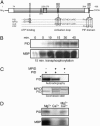
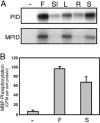
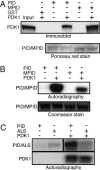
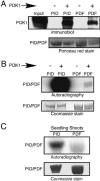
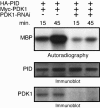

Similar articles
-
Structural and functional insights into the regulation of Arabidopsis AGC VIIIa kinases.J Biol Chem. 2006 Nov 17;281(46):35520-30. doi: 10.1074/jbc.M605167200. Epub 2006 Sep 14. J Biol Chem. 2006. PMID: 16973627
-
Plasma membrane-bound AGC3 kinases phosphorylate PIN auxin carriers at TPRXS(N/S) motifs to direct apical PIN recycling.Development. 2010 Oct;137(19):3245-55. doi: 10.1242/dev.052456. Development. 2010. PMID: 20823065
-
Regulation of auxin response by the protein kinase PINOID.Cell. 2000 Feb 18;100(4):469-78. doi: 10.1016/s0092-8674(00)80682-0. Cell. 2000. PMID: 10693763
-
Growth signalling pathways in Arabidopsis and the AGC protein kinases.Trends Plant Sci. 2003 Sep;8(9):424-31. doi: 10.1016/S1360-1385(03)00188-2. Trends Plant Sci. 2003. PMID: 13678909 Review.
-
PDK2: the missing piece in the receptor tyrosine kinase signaling pathway puzzle.Am J Physiol Endocrinol Metab. 2005 Aug;289(2):E187-96. doi: 10.1152/ajpendo.00011.2005. Am J Physiol Endocrinol Metab. 2005. PMID: 16014356 Review.
Cited by
-
An IRE-like AGC kinase gene, MtIRE, has unique expression in the invasion zone of developing root nodules in Medicago truncatula.Plant Physiol. 2007 Jun;144(2):682-94. doi: 10.1104/pp.106.092494. Epub 2007 Jan 19. Plant Physiol. 2007. PMID: 17237187 Free PMC article.
-
Focusing on the focus: what else beyond the master switches for polar cell growth?Mol Plant. 2015 Apr;8(4):582-94. doi: 10.1016/j.molp.2014.12.023. Epub 2015 Jan 9. Mol Plant. 2015. PMID: 25744359 Free PMC article. Review.
-
The MAF1 Phosphoregulatory Region Controls MAF1 Interaction with the RNA Polymerase III C34 Subunit and Transcriptional Repression in Plants.Plant Cell. 2020 Sep;32(9):3019-3035. doi: 10.1105/tpc.20.00297. Epub 2020 Jul 8. Plant Cell. 2020. PMID: 32641350 Free PMC article.
-
Phospholipases and the Network of Auxin Signal Transduction with ABP1 and TIR1 as Two Receptors: A Comprehensive and Provocative Model.Front Plant Sci. 2012 Apr 9;3:56. doi: 10.3389/fpls.2012.00056. eCollection 2012. Front Plant Sci. 2012. PMID: 22629277 Free PMC article.
-
Arabidopsis PLDzeta2 regulates vesicle trafficking and is required for auxin response.Plant Cell. 2007 Jan;19(1):281-95. doi: 10.1105/tpc.106.041426. Epub 2007 Jan 26. Plant Cell. 2007. PMID: 17259265 Free PMC article.
References
-
- Friml J., Palme K. Plant Mol. Biol. 2002;49:273–284. - PubMed
-
- Gälweiler L., Guan C., Müller A., Wisman E., Mendgen K., Yephremov A., Palme K. Science. 1998;282:2226–2230. - PubMed
-
- Steinmann T., Geldner N., Grebe M., Mangold S., Jackson C. L., Paris S., Gälweiler L., Palme K., Jürgens G. Science. 1999;286:316–318. - PubMed
-
- Geldner N., Friml J., Stierhof Y. D., Jurgens G., Palme K. Nature. 2001;413:425–428. - PubMed
-
- Geldner N., Anders N., Wolters H., Keicher J., Kornberger W., Muller P., Delbarre A., Ueda T., Nakano A., Jürgens G. Cell. 2003;112:219–230. - PubMed
Publication types
MeSH terms
Substances
Grants and funding
LinkOut - more resources
Full Text Sources
Molecular Biology Databases
Miscellaneous

